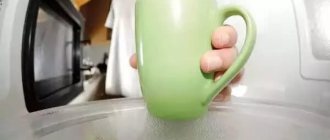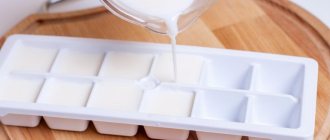The most valuable and beneficial thing for your baby, of course, is breast milk. And no alternative food can match the benefits of breastfeeding. Almost every mother knows about its benefits, but not everyone knows how to store expressed breast milk correctly in different conditions. During lactation, a young mother may face various problems and situations, for example:
- need to go to work;
- the child bit through the breast;
- the baby suddenly refuses to take the breast;
- need to leave urgently;
- any other life circumstances when the child has to be left at home with a nanny, grandmother, or relatives.
Proper storage of breast milk
And during these periods, in order to solve problems as carefully as possible, mothers try to express and leave the milk so as not to disturb the baby’s feeding regime (How to express milk by hand). And a logical question arises: what should breast milk be stored in and how long can it be stored without losing its beneficial properties?
Important! There is no need to sterilize expressed breast milk! Do not use milk after the expiration date!
How to express and how to properly store breast milk
Do you have a lot of breast milk and want to save some for the future? Do you need to go to work while you are still breastfeeding and want to delegate daytime feeding to your partner or nanny? Here are some situations in which you will need to express and store milk.
Types of containers for storing breast milk Storing milk in portions Hygiene rules when expressing breast milk
Types of containers for storing breast milk
Methods and containers for storing breast milk:
- For collection and storage, clean glass or plastic bottles with a screw cap or a hard plastic storage container with a tight-fitting lid are suitable.
- Do not use containers made from recycling group 7 material, which means the material contains plastic containing bisphenol A (BPA).
- It is also convenient to use special sterile bags for storing breast milk.
- Do not store breast milk in reusable bottle liners or regular plastic bags that are not designed to hold breast milk.
There are baby bottles that can be used to store breast milk immediately after pumping. Find out more about these bottles.
Storing milk in batches
It is recommended to store breast milk in portions of 60-120 milliliters to avoid creating unnecessary waste, as this is the most suitable volume for a single feeding (even more useful facts about breastfeeding).
Label the storage container with the date and time of pumping and the baby’s last name if the milk is to be taken to the nursery. Milk expressed earlier is used first if the shelf life of breast milk has not yet expired.
If you are going to store the container in the refrigerator, leave about 2-3 centimeters of space in the container, since liquid expands in volume when it freezes.
Hygiene rules when expressing breast milk
There are several hygiene rules to prevent bacteria from passing into breast milk and then into the baby's body.
Before using the breast pump for the first time, you need to sterilize all its components, as well as nipples, bottles and other parts that will come into contact with the breast or milk.
To sterilize, you need to boil the components for 5-10 minutes. Or use a sterilizer. Follow the manufacturer's instructions: if a different sterilization time is specified, follow that too.
Wash your hands thoroughly every time you use the breast pump.
After each use of the breast pump, wash the components with hot water and detergent, or wash them in the dishwasher if the components are suitable for this, or use a home sterilizer.
Which container to choose?
Containers for long-term storage in refrigeration devices are sold in children's stores and pharmacies. You need to choose experimentally what is most convenient for you. There are the following types of storage packaging, each with advantages and disadvantages:
- Sterile disposable bags - they have a measured volume, take up little storage space, but have only one-time use and therefore their price is not justifiably high.
- Sealed packaging containers - made of safe material, can be sterilized, which means reuse is possible, but the disadvantages are that you need to carefully monitor the tightness of the container and again the price is too high.
- Bottles with sealed lids made of food-grade plastic - made of durable material that will withstand more than one sterilization, the lid closes with a screw thread and ensures tightness even in a horizontal position, convenient for defrosting and heating and feeding the child.
How to defrost breast milk
Tips for defrosting breast milk from the freezer:
- To defrost milk from the freezer, place the container under a cool water tap. As soon as the milk begins to thaw, turn on the warm water.
- Or put your breast milk in the refrigerator to thaw - this will take about 24 hours.
- Thawed milk should be given to the child within 24 hours.
- Do not defrost milk at room temperature.
- Breast milk should not be re-frozen.
Pumping rules
To enhance lactation, it is recommended to prepare a hot drink, such as tea, before the procedure. Also, to increase the secretion of the milk product, apply a warm cloth to the mammary glands, massage them, or take a warm shower. The mammary gland needs to be provided with warmth. For pumping, 2 methods are used:
- Using your hands. Before starting the procedure, wash your hands and chest thoroughly with warm water. Then they wrap their hand around the gland and apply light pressure from the base to the nipple. The index finger and thumb should be on opposite sides of the areola. There should be no painful sensations.
- Breast pump (special manual or electric device). The device is applied to the center of the chest and pumping begins. At this time, monitor the stream so that it is not too strong. After expressing, the device is washed. The device must be disassembled so that its parts can be boiled.
The procedure can also be carried out using a bottle, the neck of which has a diameter of about 4 cm. The mammary gland is massaged. The container is heated, the neck is cooled and applied to the chest. The nipple should retract on its own, and the liquid will flow into the container thanks to the vacuum.
Can I reheat chilled breast milk?
Yes. Once stored in the refrigerator, breast milk, whether frozen or not, can be reheated if your baby prefers warm milk. However, breast milk does not have to be given warm. To feed your baby, you can use chilled milk or milk at room temperature.
After storing in the refrigerator, you need to warm up breast milk as follows:
- Place the breast milk bottle in warm water.
Warm the bottle in a bowl of warm water or using a special warmer.
- Do not heat the bottle on the stove or in the microwave.
At high temperatures, antibodies from pathogenic microbes die in breast milk; in addition, milk that is too hot can burn the baby’s oral mucosa.
- Make sure the milk is not too hot.
Before giving it to your baby, check the temperature of the breast milk by dropping a little on the back of your wrist. The milk should be warm, but not hot.
- Try to give your baby milk right away.
Once warmed, breast milk should be used within two hours.
Signs of damage
If the milk has gone bad, several signs will indicate this:
- Change in smell . It becomes unpleasant and acquires sour notes. If fermentation is active, the smell will be pungent.
- Change in taste . If in doubt, you can try a drop of milk. Normally it is sweetish. The missing product is bitter or sour.
- Changing the view . The fact that milk has spoiled is indicated by a change in its consistency. The whey rises to the top, and a substance resembling kefir remains at the bottom. It is not difficult to notice this in a transparent container. Curdled milk cannot be returned to its previous uniform consistency.
The color of milk does not indicate spoilage. If it's slightly bluish, it simply means it's low in fat. The color will change if a woman adjusts her diet.
Is stored breast milk different from fresh breast milk?
When stored in the refrigerator or freezer, breast milk may appear different in appearance from freshly expressed breast milk. Sometimes it is divided into creamy and milky layers (sometimes inexperienced parents judge the fat content of milk by this division, which is incorrect). This is normal. Gently shake the container to mix the layers.
Due to the breakdown of milk fats, thawed milk may also differ in smell or taste. However, a child can drink it, and most babies won’t even notice the difference.
You can also add fresh breast milk to thawed breast milk in a 1:1 ratio. It is recommended that both types of milk be at the same temperature as possible.
If your baby hasn't finished the defrosted milk from the bottle, it can still be used within two hours. After this, it should be poured out.
What not to do
After pumping, it is important for the mother to preserve the benefits of the milk and prevent infection from entering it. To do this, it is recommended to follow a number of rules:
- Subjecting to secondary freezing is prohibited, because this leads to the entry of pathogenic organisms;
- It is not recommended to defrost the product in the microwave, as heating occurs unevenly and some vitamins and enzymes may be destroyed;
- Do not use open fire for heating and sterilization.
By following all our recommendations, you will ensure healthy and safe nutrition for your baby for a long time and in case of your absence. Remember: breastfeeding is the best nutrition option for a baby before and after complementary feeding.
General information
Is there any point in expressing breast milk ?
Whether it is advisable to express while breastfeeding is still actively discussed by both young mothers and specialists. There are often cases when doctors promote pumping just because, without giving convincing reasons to support such a need. But if you follow WHO recommendations, there is no need to express milk with properly established lactation. Under such conditions, mother's milk is produced in the breast on demand, since the release of the hormone oxytocin occurs precisely at the moment when the mother needs to feed the baby.
Therefore, you should express milk only if there is a need to preserve it for the nursing mother. Below we will talk about when to do this, how to express milk correctly, and also how to properly store it at home.
Time management: how many times to pump during the day
If technical issues are successfully resolved, start planning a new daily routine and assigning responsibilities. It might look something like this.
- Feeding. To maintain sufficient lactation, you should be able to feed your baby 1-2 times before leaving for work, and it is especially important to maintain night feedings, so offer your baby your breast 2-3 times in the evening and at night. On weekends, holidays and other non-working days, breastfeed your baby only.
- Pumping. During the working day, be sure to express milk every 2-3 hours. Your baby should receive the last portion of pre-expressed milk or formula approximately 2 hours before you return. Accordingly, a nursing mother’s last pumping session at work should take place 2-3 hours before meeting her baby.
- Mode. If you work full time, fine; when you have the opportunity to devote the whole evening to your baby before he falls asleep after bathing. But don’t break your usual routine and put off bathing and putting your baby to bed too late, otherwise you’ll also have to go to bed late. This regime will quickly lead to severe fatigue. To avoid this, one of the family members should take on the evening chores.
Try your plan and scenario and action, especially since you will most likely have important things to do before going to work. Leave home several times for a noticeable period of time. This will allow you to take into account all the nuances and make adjustments.
Even before you go to work, you should teach your baby to eat from a bottle, and the person who will stay with him in your absence should feed him.











